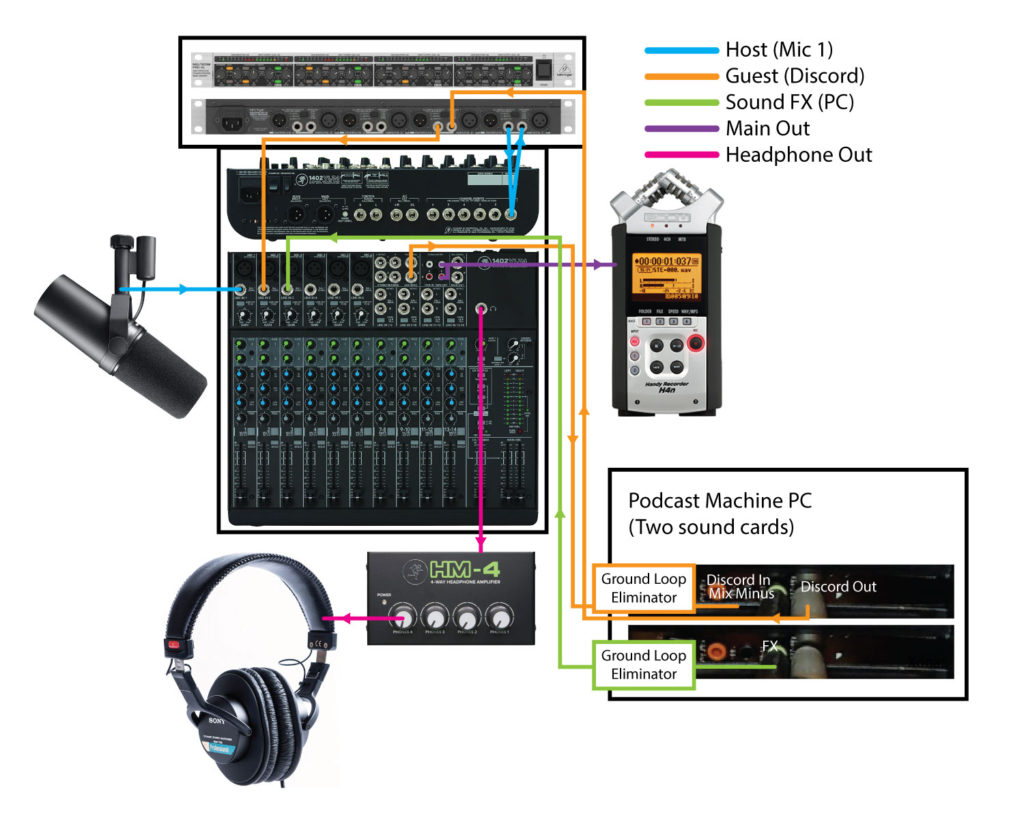**Updated 4/2022**
Product links are affiliate links. These are products I use and stand behind but I get a commission when you use my link to purchase them.
Here’s a diagram of my current podcast setup. I’ll attempt to explain what equipment I’m using and how it’s connected. Click to make the image larger.
Equipment:
- Self-built Desktop PC with two sound card (The Podcast Machine)
- A Sure SM7B microphone
- Mackie PROFX8 8-Channel Mixer
- Behringer Multicom Pro-XL Compressor/Limiter/Gate
- ZOOM Handy Recorder H4n
- ZOOM Remote Control
- Furman Power Conditioner
- Sony MDR-7506 Headphones
- BESIGN Ground Loop Isolator
- 32GIG Class 10 SD Card
- Various cables & Adapters (Stereo RCA, 1/4” to 1/8” adapters, 1/4” to RCA adapters, 1/8” stereo cables, Mic cables)
Software:
- Adobe Audition CS6 – Editing and encoding
- Mp3tag – ID3 automated tag editing
- Photoshop CS6 – Editing episode images
- Absolute RSS Editor – Feed Generator
- Podcast Soundboard – For playing music, intros, voicemails live
- Discord – Free voice and text chat
Online Services:
- Soundcloud – For hosting all mp3 media
- NameSilo.com – For domain registration and hosting (Affiliate Link)
- Bluehost.com – Web hosting (Affiliate Link)
- WordPress – Installed automatically via Bluehost.
- Blubrry PowerPress – Plugin for WordPress
Recording Setup:
- Main Mix:
- Mic 1 plugs into the first channel on the mixer.
- TRS (Tip Ring Sleeve) cable from the back of the mixer into the Compressor/Limiter/Gate and then back from the Compressor to the channel.
- Audio goes through Tape Out (L/R) using a stereo RCA to 1/8″ cable and into the H4n recorder.
- Aux Send (Provides a Mix-Minus for my cohost via Discord):
- Mic 1 plugs into the first channel on the mixer.
- Aux Send is output from mixer via stereo 1/4″ TRS to 1/8″ stereo plug and a Ground Loop Eliminator to Line In on the Podcast Machine.
- Discord is set to receive sound from Line In so co-hosts can hear everything but themselves (called a Mix-Minus).
- Line Out on the Podcast Machine sends incoming audio from Discord into Compressor/Limiter/Gate and then into Channel 3 on the Mixer.
- Input from Discord:
- Output from the soundcard runs through a mono1/8″ to 1/4″ cable into the second channel on the Compressor/Limiter/Gate and then into the 4th channel on the mixer via a 1/4″ patch cable.
- Soundboard:
- Soundboard software plays sounds when triggered sending audio out of 2nd sound card in Podcast Machine and into Channels 7/8 on the Mixer.
- OBS:
- I’m not currently live streaming video and audio to Twitch, but when I did I ran the Main Mix through a Ground Loop Eliminator and into the Line In on the 2nd sound card on the Podcast Machine.
Recording Procedure:
- I turn on the Power Conditioner which powers up my Mixer, Compressor/Limiter/Gate, and H4n Recorder.
- I insert the SD card and once the H4n boots I hit record on the remote twice to begin recording.
- Throughout the show, I can press the Record button again to place a marker in the waveform that I can see later in editing. Helps me find things later that I want to modify.
- During recording, I mix everything live. All music, fx, bumpers, voicemails, and mics are recorded to the H4n.
- After recording, I turn off the H4n and eject the SD Card, place it into a dongle on my Main PC and import the waveform.
- I import each episode to its own directory (example: podcasts/tss/283/wavform.wav)
- I open the Wav file in Audition. I trim the front and end of the episode, plus make any edits I may have tagged during the recording of the show.
- I run a Multiband Compressor and Hard Limiter on the waveform to get the most volume possible and then save it as a 16-bit mp3 file (thus keeping the original wav unedited and archived).
- I open the mp3 file into MP3tag, and I give the mp3 a title (234: The Tree Dude). then using an Action I created (see how here) I automatically add artwork, episode numbers, and other information with one click. My mp3 filename is also automatically generated (ex: 234-the-tree-dude.mp3)
- I then upload the tagged mp3 file to SoundCloud, enabling the permission to download the file.
- Using the RSS Feed SoundCloud automatically generates, I locate the address of my uploaded file and copy it.
- I log in to WordPress and create a new post and using the PowerPress plugin I paste the address of the mp3 into the appropriate box. I add a featured image, show title, and description and hit Publish.
- For That Story Show, I do not use PowerPress. Since the feed contains over 400 episodes I use Absolute RSS Editor to create a very bare-bones feed that will allow all of my podcasts to be listed at once.
Conclusion
If you have any questions about my setup, equipment, or software and you are a hobby podcaster, feel free to touch base. If you are podcasting for your business or to get rich I would urge you to find and pay a podcasting guru.
For more (possibly outdated) information on podcasting check out other podcasting articles I’ve written:
- Thoughts on Podcast Structure: Part 1, Part 2
- Podcast Starter (archived podcast)
- 5 Things You Need On Your Podcast’s Front Page
- Podcast Articles on JamesKennison.com
